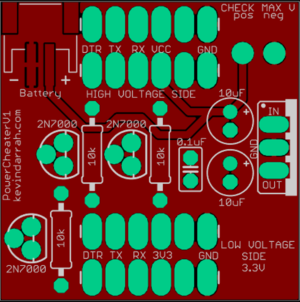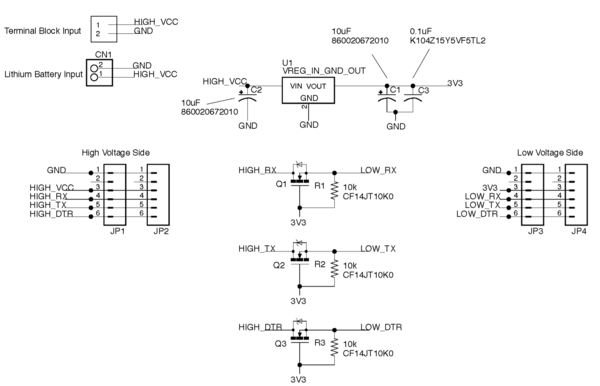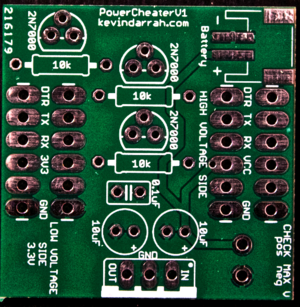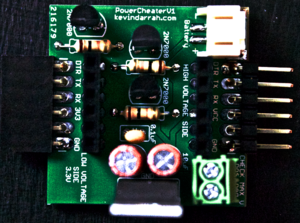Difference between revisions of "Power Cheater"
| Line 35: | Line 35: | ||
then when plugged into the Cheater board using the USB-Serial Converter: | then when plugged into the Cheater board using the USB-Serial Converter: | ||
| + | |||
[[File:PowerCheaterConnected.png|200px]] | [[File:PowerCheaterConnected.png|200px]] | ||
=== Parts === | === Parts === | ||
| − | It is up to you to order the parts. The list can be downloaded [http://www.kevindarrah.com/wp-content/uploads/2016/03/PowerCheater_v1_BOM.xlsx **HERE**]. This can be directly uploaded into [https://www.digikey.com Digikey] if you'd like. The parts are pretty self explanatory - | + | It is up to you to order the parts. The list can be downloaded [http://www.kevindarrah.com/wp-content/uploads/2016/03/PowerCheater_v1_BOM.xlsx **HERE**]. This can be directly uploaded into [https://www.digikey.com Digikey] if you'd like. The parts are pretty self explanatory - the only thing to watch out for is that you place the 6-pin right angle connectors in the right place. The USB-Serial Side takes the Male Header, while the Target Side takes the Female header. Watch out for the electrolytic capacitor polarity as well - the board has markings. The BOM has two regulators you can use with the board, but others can work as well, just as long as the pinout matches. |
| − | |||
| − | |||
| − | |||
| − | |||
| − | |||
| − | |||
| − | |||
| − | |||
| − | |||
| − | |||
| − | |||
| − | |||
| − | |||
| − | |||
| − | |||
| − | |||
| − | |||
| − | == | + | == Tutorials == |
Coming soon! | Coming soon! | ||
Latest revision as of 23:14, 9 March 2016
Contents
Introduction
The Power Cheater Board provides a simple Level Shifter between a standard USB-Serial Converter from 5V to 3.3V and also serves as a 3.3V linear power supply to the project board. It works nicely with the Cheater Board. Power can be applied to the board from the USB-Serial Converter, Externally through the terminal block, or through a JST connector via a typical Lithium battery.
The inspiration to make this board came from the need for a cheap power supply for the ESP8266 WiFi Module with low quiescent current draw. This video here describes the power supply and benchmarks the regulators that are compatible with this board:
The MOSFET Level Shifters are Explained in this video:
Here's the schematic for reference:
Assembly
The board ships as a bare board like this:
The board can be assembled easily, since it only consists of through hole components, then it looks like this:
then when plugged into the Cheater board using the USB-Serial Converter:
Parts
It is up to you to order the parts. The list can be downloaded **HERE**. This can be directly uploaded into Digikey if you'd like. The parts are pretty self explanatory - the only thing to watch out for is that you place the 6-pin right angle connectors in the right place. The USB-Serial Side takes the Male Header, while the Target Side takes the Female header. Watch out for the electrolytic capacitor polarity as well - the board has markings. The BOM has two regulators you can use with the board, but others can work as well, just as long as the pinout matches.
Tutorials
Coming soon!




